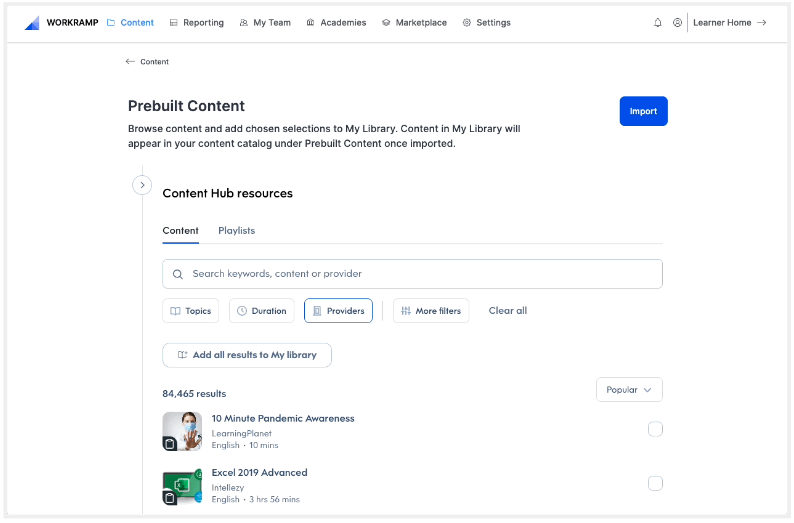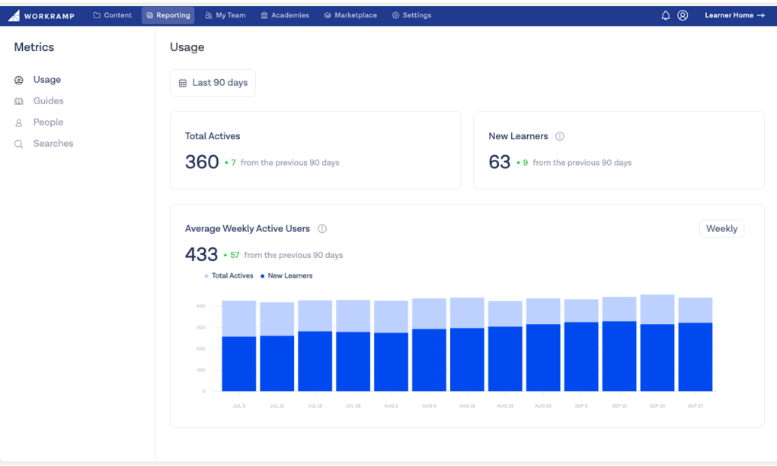How Managers Can Encourage Learning: 7 Effective Strategies
Elise Dopson | WorkRamp Contributor
View bioLearning Tips Straight to Your Inbox
While most employees want learning and development opportunities from their employers, the reality is: a large portion of them don’t make use of the training materials already available to them.
As a manager, it’s your job to encourage continuous learning and improvement. If not, team members may not understand the sheer volume of resources available—or worse, find a new employer that actively promotes employee training.
Most managers struggle to balance the fine line between pushy and motivating. This article shares how to achieve the latter so that you can encourage ongoing employee learning.
In this post:
Why must managers encourage employee learning?
Encouraging staff to learn can improve retention—a known problem for 93 percent of managers, given the current economic climate.
Providing organizational learning opportunities and encouraging team members to use training materials can go a long way in retaining employees, especially considering team members who feel their skills are not being put to good use are up to 10x more likely to search for a new job.
Managers who encourage employee development can close skill gaps, too. McKinsey found nine in 10 leaders are already facing skills gaps amongst their teams or expect to develop them within the next five years.
Instead of hiring new employees to cover knowledge gaps, which can be time-consuming and expensive, existing teams that are encouraged to learn and given professional development opportunities can fill the gaps.
Read more: What is an Employee Training Plan Template?

7 ways managers can encourage learning
Now that we understand the importance of creating a learning organization, let’s explore seven ways managers can support learning among their teams.
Build a learning culture
Teamwork plays an essential role in encouraging employees to learn. No matter how often a manager encourages team members to take new training courses, you’ll have difficulty engaging employees individually without buy-in from the entire team.
A learning culture ensures you’re starting on the right foot. It provides a strong foundation for managers to encourage further learning and development. Teams are already accustomed to seeking, sharing, and implementing new information.
The simplest way to build a culture of learning is to make development a core business value. From employee onboarding to weekly standups, make it clear that growth is only possible by continually learning. That way, any new learning initiatives from managers won’t appear out of the blue. Instead, employees will already be accustomed to learning.
Introduce new content formats
Employees often disengage from learning activities that don’t suit their learning style.
For example, if someone on your customer service team is a visual learner, having them sit through a 30-minute presentation makes them unlikely to meet learning objectives—no matter how hard their manager tries to encourage them.
Introduce new content formats to promote employee engagement amongst team members with different learning styles.
For example:
- Kinesthetic learners. The most popular learning style, these team members learn by doing. Popular content formats to engage these learners include roleplays and demonstrations.
- Auditory learners. These learners absorb information best through audio. Introduce podcasts, interviews, and group discussions to cater to auditory learners.
- Visual learners. These people learn best by seeing things. Hosting demonstrations, using GIFs, and infographics are excellent formats for this type of employee.
- Reading or writing learners. As the description suggests, this type of employee benefits from reading or writing training material. Content formats to engage this type of learner include infographics, quizzes, or whitepapers.
Read more: eLearning Content: 24 Types to Include in Training
The Learning Cloud from WorkRamp accommodates all of these content formats and more. With a library of prebuilt learning content, you can quickly transform one training material into various forms, securing buy-in from your team from the get-go.
 Make learning accessible to all
Make learning accessible to all
Can all employees make the best use of the training materials you’ve provided?
Granted, a variety of content formats can make learning more accessible. But if you’re limiting your delivery methods, learners might have to clear more obstacles before buying into new learning initiatives.
Let’s put this into practice and say you’ve invited an industry expert to deliver a presentation on how sales reps can convert more customers. The problem is the meeting is scheduled in person on a Tuesday at 9 a.m.
The following team members aren’t able to attend:
- Melanie, who works remotely on Thursdays
- Kevin, who is dropping his daughter off at school
- Tanya, who already has a client meeting booked at the same time
Instead of hosting the presentation in person, ask employees to share their questions in advance to ask the expert without physically being in the room.
Then, record the session, upload it to your LMS, and transcribe key points for visual learners.
Each element makes the presentation more inclusive and accessible for team members with different learning styles.
Create personalized learning paths
You can’t take a one-size-fits-all approach to L&D. Team members have different strengths, weaknesses, and roles. For example, giving customer support teams the same training materials as an administrative assistant wouldn’t make sense.
Cater to these differences with personalized learning paths. For example, each path can start with foundational modules each new hire has to take (such as health and safety, product, and compliance training).
Once completed, employees can move on to job-specific training—the personalized approach proven to increase learner engagement and performance.
Speed up this process with WorkRamp’s employee onboarding features. Assign modules to new hires based on their role, team, or seniority so that you can spend more time on higher-impact L&D initiatives.
 Reward and incentivize employees who share new learning
Reward and incentivize employees who share new learning
Companies with a learning culture make continuous learning standard practice. Take that one step further—and alleviate a manager’s responsibility to promote learning—by encouraging your team to share new learnings.
This could be:
- Regular “share-your-learning” sessions
- Mentoring, which pairs experienced staff with new or less skilled employees
- An active Slack channel that sends regular reminders for employees to share something they learned that day, week, or month
Read more: What is Social Learning & How to Use it in the Workplace
Sharing may not come naturally to all employees. So incentivize by rewarding employees who teach others. The allure of profit-sharing or public recognition can be the nudge your team needs to continue learning.
Knowledge sharing can help with retention, too. Studies show that 86 percent of employees prefer to work for an organization that rewards outcomes over outputs.
Gamify the learning experience
Managers can encourage learning by making training programs more engaging. For example, gamification, which introduces game-style elements to traditional training, is one way to keep learning fun.
Gartner reports more than 70 percent of organizations already use this type of edutainment.
Implement the same strategy and gamify the learning experience with:
- End-of-module quizzes
- Leaderboards that allow teams to compete against each other
- Points-based systems that unlock rewards or badges (the more employees learn, the more rewards they get)
The team at GRIN, a creator management platform, used WorkRamp to gamify the learning experience. Angela Walter, GRIN’s RevOps Manager of Enablement, says, “With WorkRamp, we built out certification paths according to each GTM role that included some self-led modules, a few live sessions, and a final narrative presentation.
“For Business Development teams, we put them through the same modules, but instead utilized the Challenges feature to help scale the final knowledge check with a recorded narrative test.”
It’s a strategy so effective that Angela says, “other departments are asking for access and asking to have admin access to build learning modules for their teams.”
Gather learner feedback regularly
Are your L&D initiatives working? Dig deep and gather learner feedback. This data will help you identify obstacles and opportunities—allowing managers to give more personalized learning support.
Use employee stay interviews to get feedback on your L&D program each quarter. Stay interviews are a great way to gather qualitative data that explains a learner’s thoughts, feelings, and behaviors in plain text—before a lack of learning forces them to look for another job.
Combine this with quantitative data from your LMS to determine:
- Which type of learning content best engages your team?
- Are there any topics your employees seem to struggle with?
WorkRamp provides comprehensive tracking and reporting tools to help determine whether your learning objectives are (or aren’t) being met.

Encourage your team to learn with WorkRamp
As a manager, it’s your job to encourage your team to learn. The key is to build a culture of learning within your organization, make training materials accessible, and reward employees who participate.
Make your job easier using a learning platform that allows you to leverage various training materials under one (virtual) roof.
The Learning Cloud makes it easier for managers to encourage learning. Want to see it in action? Contact us to schedule a free, personalized demo.
Complete the form for a custom demo.
Recent Posts
- Top LMS Integrations That Power Smarter, Faster Learning July 2, 2025
- Introducing WorkRamp Analytics Studio: Unlocking Your Data Insights with AI June 30, 2025
- 11 AI LMS for AI-Powered Learning June 27, 2025
- The Best LMS Platforms for Customer Retention (2025 Guide) June 27, 2025
- 11 Best AI Learning Platforms June 16, 2025
Elise Dopson
WorkRamp ContributorElise Dopson is a freelance writer for B2B SaaS companies. She’s also the co-founder of Peak Freelance and mom to an adorable Spaniel pup.
You might also like
Use training content to enhance employees' knowledge and skills
Training is the main factor that drives employee engagement and performance. Discover the best types of training content to add to your program
Read More
Try these strategies to improve employee engagement and performance
Companies with strong cultures see greater employee engagement and increased productivity. Learn to create a culture that promotes growth, helps you retain top talent, and drives results.
Read More
How to create employee development plans that work
By creating excellent employee development plans, you give team members a chance to reach their full potential—and show them their success is a priority.
Read More
Decrease Ramp Time and Increase Revenue
Get in touch to learn how WorkRamp can help you achieve your learning and development goals.
Request a Demo




